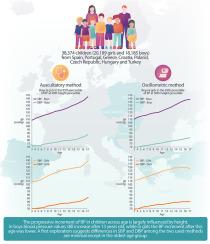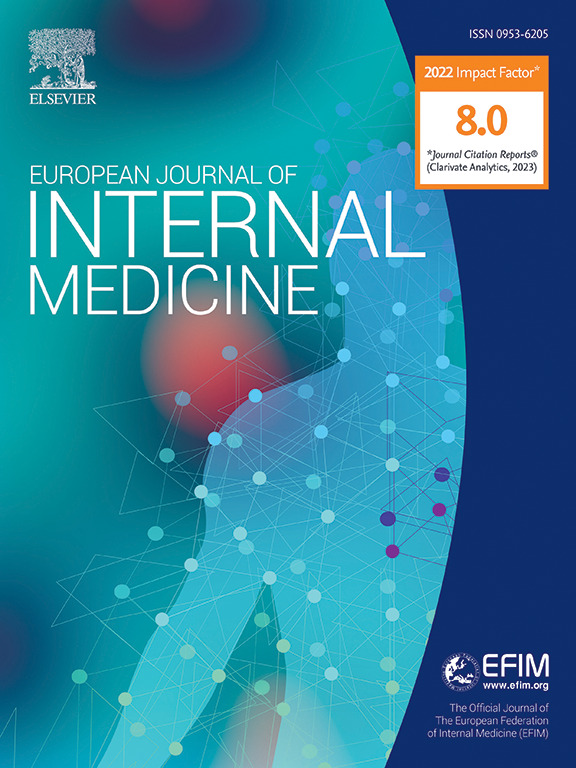八个欧洲国家健康正常体重儿童和青少年的血压值:听诊和振荡测量。
IF 6.1
2区 医学
Q1 MEDICINE, GENERAL & INTERNAL
引用次数: 0
摘要
目的:本研究的目的是在8个欧洲国家的3-17岁的健康和正常体重的儿童和青少年的大样本中,使用标准化的血压测量方法,通过振荡和听诊方法,提供经性别、年龄和身高调整后的血压值。对象和方法:在38.374名儿童(20.189名女孩)中,按照欧洲高血压学会指南测量血压值。为了得到血压百分位数,估计了年龄和身高同时对血压水平的影响。结果:根据身高、年龄、性别计算第90、95、99个收缩期和舒张期百分位数对应的血压估计值。在这两种方法中,第90和第95百分位的收缩压随年龄和身高的增加而增加,男孩比女孩高,而舒张压没有差异。该研究说明了在第50个高度百分位数上,两性用示波法和听诊法测得的第95个血压百分位数的差异。在13岁时,对应于第95百分位的阈值在性别和测量方法中均接近130/80 mmHg,在17岁时,男孩的阈值约为140/90 mmHg。结论:不同年龄儿童血压的进行性升高受身高的影响较大。男孩的血压值在13岁后仍然升高,而女孩的血压值在13岁后的升高较低。两种方法之间的收缩压和舒张压差异很小,除了年龄最大的年龄组。本文章由计算机程序翻译,如有差异,请以英文原文为准。

Blood pressure values in healthy normal weight children and adolescents in eight European countries: auscultatory and oscillometric measurements
Aim: The aim of the study is to provide BP values adjusted for sex, age and height in a large sample of healthy and normal weight children and adolescents 3–17 years in eight European countries, using standardized BP measurement by oscillometric and auscultatory methods.
Subjects and Methods
In 38.374 children (20.189 girls) BP values were measured following the European Society of Hypertension guidelines. To derive BP percentiles the estimated influences of age and height simultaneously on BP levels were estimated.
Results
The estimated BP values corresponding to 90th, 95th, and 99th systolic and diastolic percentiles according to height percentiles, age and sex were calculated. In both methods, the 90th and 95th percentiles of systolic blood pressure, tended to increase with both age and height, higher in boys than in girls without differences in diastolic blood pressure. The study illustrates the differences in 95th Blood Pressure percentile obtained by oscillometric and auscultatory methods in both sexes at the 50th height percentile. The threshold corresponding to 95th percentile at age 13 is close to 130/80 mmHg in both sexes and measurement methods at median height and at age 17 it is around 140/90 mmHg for boys.
Conclusions
The progressive increment of blood pressure in children across age is largely influenced by height. In boys blood pressure values still increase after 13 years old, while in girls the BP increment after this age was lower. Differences in systolic blood pressure and diastolic blood pressure among the two used methods are minimal except in the oldest age group.
求助全文
通过发布文献求助,成功后即可免费获取论文全文。
去求助
来源期刊
CiteScore
9.60
自引率
6.20%
发文量
364
审稿时长
20 days
期刊介绍:
The European Journal of Internal Medicine serves as the official journal of the European Federation of Internal Medicine and is the primary scientific reference for European academic and non-academic internists. It is dedicated to advancing science and practice in internal medicine across Europe. The journal publishes original articles, editorials, reviews, internal medicine flashcards, and other relevant information in the field. Both translational medicine and clinical studies are emphasized. EJIM aspires to be a leading platform for excellent clinical studies, with a focus on enhancing the quality of healthcare in European hospitals.

 求助内容:
求助内容: 应助结果提醒方式:
应助结果提醒方式:


